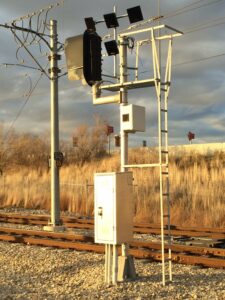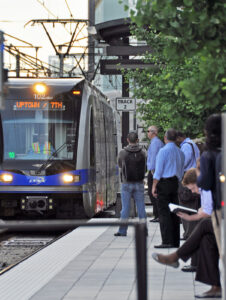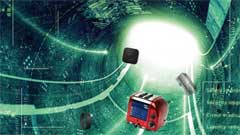RFID in the Middle East is taking off, with the aviation industry deploying the technology to increase safety and security:
Big growth projected in RFID solutions deployment by ME
Suspect Bag Tracking System for Saudi airport
UAE and other Gulf airports benefits from EnTrackBag technology
Two to Three per cent suspect checked-in baggage at airports
Dubai, May 12, 2014: The use of Radio-Frequency Identification (RFID) in the aviation industry in the Middle East region is expected to grow significantly in the next two years with an increasing number of airports, cargo and flight catering companies, duty free facilities and customs authorities deploying this modern technology in their operations.
The Dubai Internet City-based TrackIT Solutions is utilizing the 14th Airport Show to create better awareness about its RFID solutions, including the world’s first Suspect Bag Tracking System – EnTrackBag – designed to meet the needs and expectation of the aviation industry for a secure and safer environment for millions of air passengers across the world.
Soma SekharVedantam, CEO, TrackIT Solutions, said two airports in the UAE and the other Gulf airports have already deployed EnTrackBag which has been helping the custom officials in identifying the suspect bags from the check-in baggage of the arriving passengers. The cutting-edge technology is due to be deployed at an airport in Saudi Arabia in the next six months. “If you look at the pace of RFID solutions deployment in the Middle East, we can say that the next two years will bring all the airports in the region under the RFID technology coverage. We are holding discussions with several organizations and could see the trend taking shape,” he said.
EnTrackBag is a comprehensive Suspect Bag Tracking System for airport customers that facilitate airport security/custom officials to identify and uniquely tag a suspect bag. Subsequently that bag can be unobtrusively tracked or located and relevant officials can then be alerted. The system also enables airports to profile passengers and build a database that can be used to significantly enhance security.
It supports sniffer dog identified suspect bag and could be integrated with Baggage Handling System (BHS), Screening System and Passenger data. No false or repeat alarms come from the system which also has the ability to profile passengers and uniquely identify every suspect bag in addition to automatic reporting. The hardware for the EnTrackBag is from Motorola, while the software comes from TrackIT.
EnTrackAsset offers a strong asset tracking solution to build and maintain master asset registry for various entities of airports. The system enables tracking of movable and non-movable assets throughout the life cycle of asset from purchase till disposal.
For the MRO industry, EnTrack product suite helps Maintenance and Engineering Department in tracking tools and spare parts. EnTrack product suite helps flight catering in tracking employees in the facility, kitchen equipment and knives from management and security perspective.
EnTrack product suite helps in tracking the Linen and Life jackets onboard the aircraft from sanity perspective. Linen Tracking and Management on ground is a huge task. EnTrack Suite assists in automating and streamlining the operations. For the Duty Free facilities, EnTrack product suite provides item level tracking and management of higher value duty free goods in addition to providing security in the facility.
EnTrack product suite provides a complete real time and nested tracking solution for Air Cargo Unit Load Devices (ULDs) and Pallets. ULD is a pallet or container used to load luggage, freight, and mail on wide-body aircraft and specific narrow-body aircraft. With the increasing number of wide-bodied aircraft now in operation, ULD management is a key element of high efficiency in air transport.
The B2B event, which got off to a flying start on Sunday with 25 exhibitors from 39 countries on board, is seeing the launch of 40 new technology, products and solutions by various global companies looking for a strong footing in the region’s highly-promising aviation markets.
The Middle East region is investing $100 billion, including $40 billion in the six GCC states, for airports expansion and new developments to handle the anticipated growth in air traffic.
The Middle East, according to International Air Transport Association (IATA), is expected to record the fastest growth rate of 6.6 per cent until 2016, making it the second-fastest growing aviation market in the world.
Airports in the MENA region, currently under various stages of expansion and upgrades, are projected to cater to 400 million passengers by 2020, with the UAE airports taking one-fourth of the share in the anticipated growth in air passenger traffic.
Dubai is expected to attract an estimated 25 million visitors in 2020 during the six month run of the World Expo world’s third biggest event after Olympics and FIFA World Cup.
The B2B event is specially focused on the Middle East, North Africa and South Asia (MENASA) region where the airport developments remains a top priority with the governments’ driving the aviation growth as a key contributor to the economic consolidation.
For further information, please visit TrackIT website www.trackitme.com
For media enquiries, please contact us:
Nadd Al Shiba PR & Event Management
Tel: +9714-2566707
Fax: +9714-2566704
info@naddalshiba.com
www.naddalshiba.com
© Press Release 2014
![]() April 10, 2015 – The Swiftsure Group will be among more than 38,000 healthcare IT professionals, clinicians, executives and vendors convening in Chicago April 12-16 for the HIMSS15 exhibition, the world’s largest and most important healthcare IT trade show.
April 10, 2015 – The Swiftsure Group will be among more than 38,000 healthcare IT professionals, clinicians, executives and vendors convening in Chicago April 12-16 for the HIMSS15 exhibition, the world’s largest and most important healthcare IT trade show.



















